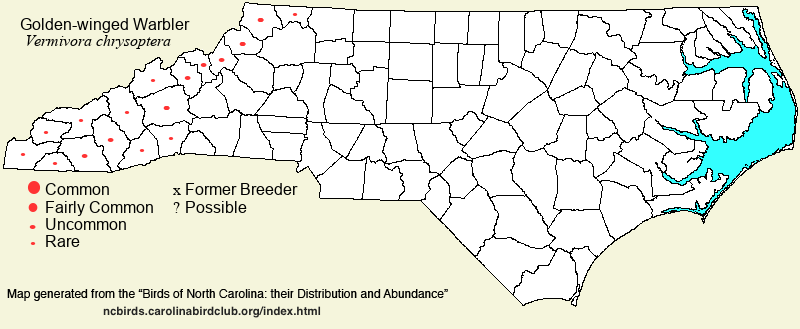 |  |
|
Golden-winged Warbler - Vermivora chrysoptera PARULIDAE Members: | Search Common: Search Scientific: |
|
|
|||||||
| General Comments |
The Golden-winged Warbler, though it looks completely different from its closest "cousin", the Blue-winged Warbler, often interbreeds with it -- producing Brewster's and Lawrence's warbler hybrids -- and this mixing of genes is one of the factors for a continent-wide decline in the species. In fact, it has been petitioned to the US Fish and Wildlife Service for Federal listing. The species nests mainly north of the range of the Blue-winged, or higher in elevation in the Appalachians than the Blue-winged. Golden-wingeds have mostly declined in our mountains to an "uncommon" status, from "locally fairly common" a decade or two ago. Downstate, it is considerably less numerous than the Blue-winged in migration. Breeding habitat of the species in the mountains is overgrown fields and clearcuts, brushy areas in wide powerline clearings, shrubby bogs, and wooded borders; usually small trees, especially Black Locusts, are needed for singing perches for the males. Controversy has arisen regarding management of habitat for the species on US Forest Service land; habitat can be created by clearcutting, and for a handful of years the species can occupy a clearcut before the vegetation becomes too tall for nesting. On the other hand, favored sites tend to be rich and moist, with Black Locust saplings being common; these sites were formerly rich coves and other moist hardwood slopes with a high diversity of wildflowers, salamanders, and other biota. Migrants, like most warblers, favor hardwood trees, usually in the canopy of bottomlands or other moist forests and woods.
Blue-winged and Golden-winged warblers breed to produce hybrid offspring falling into two forms known as "Brewster's Warbler" and "Lawrence's Warbler". Brewster's is a first generation hybrid, and is by far more common. Lawrence's is much rarer, and is believed to be a backcross of two Brewster's Warblers, or one Brewster's with a Blue-winged or Golden-winged. Brewster's and Lawrence's warblers are fertile, unlike many hybrids, and their descendants may show varying degrees of deviation from the normal parent and hybrid forms. Habits, habitats, and dates of the hybrids are similar to those of the parent species. Both forms occur in the state in migration, and a few Brewster's have been present in the mountains in summer and have mated with Golden-wingeds. Brewster's is very rare in migration, whereas the Lawrence's is casual to very rare, and has apparently been been reported as a possible breeder only once -- in northern Watauga in late May 2020. | ||||||
| Breeding Status | Breeder | ||||||
| NC BRC List | Definitive | ||||||
| State Status | SC | ||||||
| U.S. Status | |||||||
| State Rank | S2S3B | ||||||
| Global Rank | G4 | ||||||
| Coastal Plain | Transient. In spring, casual (i.e., essentially avoids the region); in fall, very rare throughout, even to the coast. Mainly late Apr to early May (few records), and mid-Aug to early Oct. Peak counts: | ||||||
| Piedmont | Transient. Rare in both spring and fall, slightly more "numerous" in the western half of the region (as the main migration is west of the Appalachians), but still difficult to find in migration. Mainly late Apr to mid-May, and mid-Aug to late Sep. One seen and recorded singing in northern Wake from 29 May - 1 Jun 2023 was quite late. Peak counts: | ||||||
| Mountains | Summer resident, and transient; decreasing at an alarming rate. Nests mainly at middle elevations (generally from 3,000 feet to 4,500 feet). Currently (2024), rare to very uncommon over most of the same range. Formerly fairly common at least locally in the southern mountains, mainly in Jackson, Macon, and Graham counties. Nests (or nested) down to about 2,000 feet (and perhaps lower in Cherokee). Uncommon as a migrant in spring and fall. Mainly late Apr to late Sep. Peak counts: | ||||||
| Finding Tips |
There are still a few places/roads where birders have a likely chance to see the species in a given morning. The Max Patch Road in northeastern Haywood is reliable, and NC 143 near Stecoah Gap in Graham is also reliable. ** to *** | ||||||
| Attribution | LeGrand[2024-11-08], LeGrand[2023-08-10], LeGrand[2023-04-03] | ||||||
| NC Map Map depicts all counties with a report (transient or resident) for the species. | Click on county for list of all known species. |
| NC Breeding Season Map Map depicts assumed breeding season abundance for the species. |  |